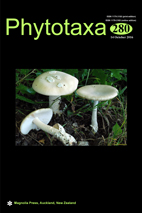Abstract
The genus Microcostatus was described for the first time by Johansen & Sray in 1998. They established a new genus in the family Naviculaceae for Navicula krasskei. Subsequently, Lange-Bertalot proposed the transfer of further species from the genus Navicula to the Microcostatus. Species determination is very difficult using light microscopy since species are small and very similar to each other, and only ultrastructural features allow their placement in the genus. The aim of this paper was to describe morphologically and ecologically two new species of the genus Microcostatus from aerial habitats in Germany and Poland and compare their morphologies with the original gathering of Navicula egregia. Polish material was collected once a month from April to November 2013 at two sampling sites located in cultivated fields. For comparison, German original material from the Hustedt Collection was also observed. During this study, Microcostatus aerophilus sp. nov. and M. edaphicus sp. nov. were described, and M. egregius was also illustrated and discussed in detail. The species mentioned are very similar to each other under light microscopy. They differ slightly in dimension and number of striae. Only SEM observations showed morphological differences, such as the presence of conopeum or pseudoconopeum.

